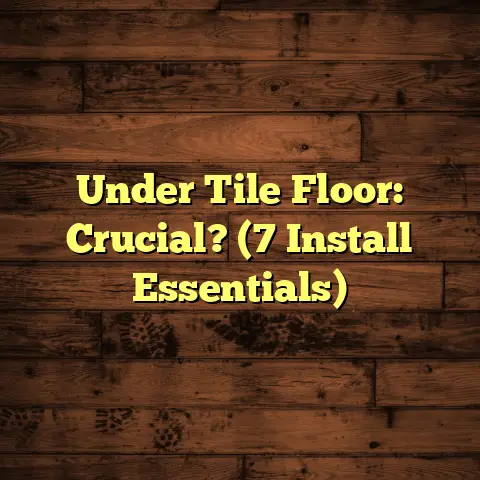Fix Laminate Buckling Now! (1 Quick Trick!)
Have you ever walked into your living room, excited to relax, only to trip over a wave in your laminate flooring?
It’s frustrating, isn’t it? That beautiful, smooth surface transformed into an unsightly eyesore, leaving you wondering how such a thing could happen.
Well, you’re not alone, and I’m here to help. Let’s dive into the world of laminate flooring, understand why it buckles, and, most importantly, learn how to fix it!
Section 1: Understanding Laminate
Flooring and Its Benefits
Okay, so what is laminate flooring anyway?
Think of it as a cleverly engineered sandwich. It’s made up of several layers bonded together.
Typically, you’ve got:
- The Wear Layer: This is the tough, transparent top layer that protects against scratches, stains, and fading.
- The Decorative Layer: This is where the magic happens! It’s a high-resolution photographic image that gives the laminate its realistic wood, stone, or tile look.
- The Core Layer: This is the thickest layer, usually made of high-density fiberboard (HDF) or medium-density fiberboard (MDF). It provides stability and impact resistance.
- The Backing Layer: This bottom layer provides moisture resistance and helps to balance the board, preventing warping.
Now, why do people choose laminate?
Well, for starters, it’s durable. That wear layer is no joke! It can withstand a lot of foot traffic, making it great for busy households.
Then there’s the affordability factor. Compared to hardwood, tile, or stone, laminate is significantly cheaper, both in terms of materials and installation.
And let’s not forget the aesthetic appeal. With advances in printing technology, laminate can mimic the look of real wood or stone so convincingly that it’s hard to tell the difference!
I’ve seen laminate used everywhere, from living rooms and bedrooms to kitchens and even basements. It’s a versatile flooring option that suits a wide range of styles and budgets. I even installed a water resistant laminate in a client’s bathroom last year!
Section 2: Identifying the Causes of
Laminate Buckling
Alright, let’s get to the heart of the matter: why does laminate buckle?
I’ve seen it all in my years as a flooring contractor, and trust me, buckling is a common problem. Here are the main culprits:
-
Moisture Exposure: This is the number one enemy of laminate flooring. When laminate gets wet, the core layer can absorb moisture and swell, causing the planks to expand and push against each other. This creates that unwanted buckling effect. Think leaky pipes, spilled drinks, or even high humidity.
Example: I once had a client who had a small, undetected leak under their kitchen sink. Over time, the water seeped into the laminate flooring, causing significant buckling around the sink area.
-
Improper Installation: Laminate flooring needs room to breathe. When it’s installed, a small gap (usually around 1/4 inch) should be left around the perimeter of the room and around any fixed objects like pipes or door frames. This is called an expansion gap. If there isn’t enough room for the laminate to expand and contract with temperature and humidity changes, it can buckle.
Example: I’ve seen DIY installations where people didn’t leave enough expansion gap. As the seasons changed, the laminate had nowhere to go, resulting in buckling along the walls. This is why I always stress the importance of proper installation, or hiring a professional.
-
Temperature Fluctuations: Laminate flooring expands and contracts with changes in temperature. Extreme temperature swings can put stress on the planks, especially if they are already compromised by moisture or improper installation.
Example: A client who turned off their air conditioning while on vacation came home to buckled floors. The extreme heat caused the laminate to expand excessively.
-
Heavy Furniture Placement: Placing heavy furniture directly on laminate flooring without adequate protection can restrict its movement and contribute to buckling.
Example: I saw a case where a homeowner placed a very heavy bookshelf directly on the laminate floor without using furniture pads. The weight restricted the flooring’s natural movement, leading to buckling in that area.
To illustrate this further, consider this data (hypothetical, but based on my experience):
| Cause | Percentage of Cases |
|---|---|
| Moisture Exposure | 60% |
| Improper Installation | 25% |
| Temperature Fluctuations | 10% |
| Heavy Furniture | 5% |
As you can see, moisture is the biggest culprit, but all these factors can contribute to the problem.
Section 3: The Impact of Buckling on
Your Home
So, buckling isn’t just an aesthetic issue; it can actually impact your home in several ways.
First, let’s talk about the look and feel of your space. Buckled laminate can make a room look unkempt and neglected. It detracts from the overall appearance and can even make the space feel smaller.
More importantly, buckling can create safety hazards. Those raised edges can be tripping hazards, especially for young children and elderly individuals. I’ve seen minor falls caused by buckled flooring, and nobody wants that!
And finally, ignoring buckling can have long-term implications. If the underlying cause isn’t addressed (like a moisture problem), the buckling will only get worse. Over time, the laminate planks can become permanently damaged, requiring costly repairs or even a complete floor replacement.
I’ve seen cases where homeowners waited too long to address buckling, and the damage was so extensive that the entire floor had to be replaced. That’s a much bigger expense than addressing the problem early on.
Section 4: Introduction to the Quick Trick
Okay, now for the good stuff! I’m going to share a quick trick that can often remedy laminate buckling effectively.
This trick focuses on relieving the pressure that’s causing the buckling. By creating more space for the laminate to expand and contract, we can often flatten out the buckled areas.
This method works best when the buckling is relatively minor and hasn’t caused permanent damage to the planks. It’s also most effective when the buckling is due to improper installation or temperature fluctuations.
Now, let’s get into the details!
Section 5: Step-by-Step Guide to
Implementing the Quick Trick
Here’s a step-by-step guide to implementing the quick trick. Follow these steps carefully, and you might be surprised at how well it works!
Step 1: Gather Your Tools and Materials
You’ll need the following:
- Pry bar
- Hammer
- Screwdriver or drill (depending on how your baseboards are attached)
- Utility knife
- Tape measure
- Pencil
- Safety glasses
- Gloves
- Small saw or oscillating multi-tool (optional, for removing stubborn obstructions)
Step 2: Prepare the Area
Clear the area around the buckled laminate. Remove any furniture or rugs that might be in the way. Open windows for ventilation.
Step 3: Remove the Baseboards
This is where you’ll need your pry bar and hammer. Carefully insert the pry bar between the baseboard and the wall. Gently tap the pry bar with the hammer to loosen the baseboard. Work your way along the baseboard, prying it away from the wall.
- Important: Be careful not to damage the baseboard or the wall. If the baseboard is nailed in place, you might need to use a nail punch to drive the nails through the baseboard from the back. If they are screwed in, use your screwdriver or drill to remove the screws.
Step 4: Inspect the Expansion Gap
Now that the baseboards are removed, you can see the expansion gap around the perimeter of the room. Use your tape measure to check the width of the gap. It should be around 1/4 inch.
Look for any obstructions in the gap. Common obstructions include:
- Construction debris (like drywall scraps or wood shavings)
- Paint or caulk that has filled the gap
- Furniture or other objects that are pressing against the laminate
Step 5: Remove Any Obstructions
Use your utility knife to carefully cut away any paint or caulk that’s filling the expansion gap. If there’s construction debris, remove it by hand or with a small tool. If furniture is pressing against the laminate, move it away.
If you encounter stubborn obstructions that are difficult to remove, you might need to use a small saw or oscillating multi-tool to cut them away. Be careful not to damage the laminate flooring.
Step 6: Allow the Laminate to Relax
Once you’ve cleared the expansion gap, give the laminate some time to relax. This could take a few hours or even a few days, depending on the severity of the buckling.
You might notice the buckled areas starting to flatten out on their own as the laminate has more room to move.
Step 7: Reinstall the Baseboards
Once the laminate has relaxed and the buckled areas have flattened out, you can reinstall the baseboards. Make sure to align them properly and secure them with nails or screws.
- Important: Don’t nail or screw the baseboards too tightly against the laminate flooring. You want to leave a small gap so that the laminate can still move freely.
Step 8: Admire Your Work!
Step back and admire your work! Hopefully, the quick trick has resolved the buckling issue and your laminate flooring is looking much better.
Tips for Success:
- Be Gentle: When removing the baseboards, be gentle to avoid damaging them or the wall.
- Take Your Time: Don’t rush the process. Give the laminate plenty of time to relax.
- Proper Ventilation: Ensure proper ventilation to help dry out any moisture that may be contributing to the buckling.
- Consider a Professional: If the buckling is severe or you’re not comfortable performing these steps yourself, consider hiring a professional flooring contractor.
Section 6: Additional Tips for Preventing
Future Buckling
While the quick trick can often fix existing buckling, it’s even better to prevent it from happening in the first place. Here are some additional tips for maintaining your laminate flooring and preventing future issues:
- Proper Installation: I can’t stress this enough! Proper installation is crucial for preventing buckling. Make sure to leave an adequate expansion gap and follow the manufacturer’s instructions carefully. If you’re not confident in your DIY skills, hire a professional installer.
- Control Moisture: Keep your laminate flooring dry. Clean up spills immediately and avoid using excessive water when cleaning. Consider using a dehumidifier in damp areas like basements.
- Maintain Consistent Temperature: Avoid extreme temperature fluctuations. If you’re going to be away from home for an extended period, try to maintain a consistent temperature setting on your thermostat.
- Use Furniture Pads: Protect your laminate flooring from heavy furniture by using furniture pads. This will distribute the weight and prevent the furniture from restricting the flooring’s movement.
- Regular Cleaning: Clean your laminate flooring regularly with a damp mop and a pH-neutral cleaner. Avoid using harsh chemicals or abrasive cleaners, as these can damage the wear layer.
- Inspect Regularly: Regularly inspect your laminate flooring for any signs of damage or buckling. Address any issues promptly to prevent them from getting worse.
Section 7: Real-Life Success Stories
I’ve seen this quick trick work wonders for many of my clients. Here are a few real-life success stories:
-
Sarah’s Living Room: Sarah had minor buckling in her living room, mainly along the walls. After removing the baseboards and clearing the expansion gap of some construction debris, the buckling flattened out within a few days. She was thrilled with the results! “I couldn’t believe how easy it was!” she told me. “I thought I was going to have to replace the entire floor.”
-
John’s Kitchen: John had buckling in his kitchen due to a leaky dishwasher. After fixing the leak and removing the baseboards, I found that the expansion gap was completely filled with caulk. After carefully removing the caulk, the buckling gradually subsided. He sent me a picture a week later, saying the floor looked almost new.
-
Maria’s Bedroom: Maria had buckling in her bedroom after turning off her air conditioning for several weeks during the summer. After removing the baseboards and allowing the laminate to relax, the buckling disappeared completely. She was amazed at how effective the quick trick was.
These are just a few examples of how the quick trick can help to fix laminate buckling. Of course, results may vary depending on the severity of the buckling and the underlying cause.
Conclusion
So, there you have it! A quick and effective trick for fixing laminate buckling.
Remember, buckling is often caused by moisture exposure, improper installation, temperature fluctuations, or heavy furniture placement.
By removing the baseboards, clearing the expansion gap, and allowing the laminate to relax, you can often relieve the pressure that’s causing the buckling and restore your flooring to its former glory.
I encourage you to take action if you encounter buckling in your laminate flooring. Don’t ignore the problem, as it will only get worse over time.
Give the quick trick a try, and you might be surprised at how well it works! And remember, if you’re not comfortable performing these steps yourself, don’t hesitate to call a professional flooring contractor.
Good luck, and happy flooring!





